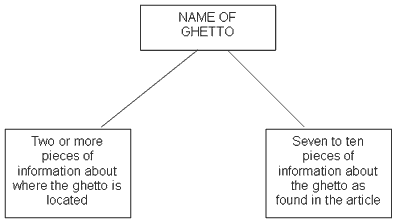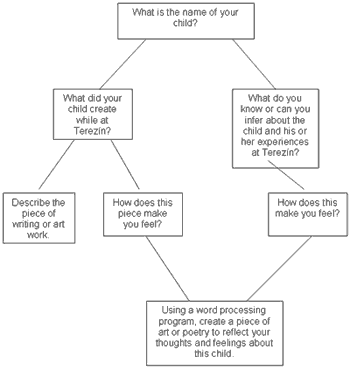
Background
Lesson
Home > Archive > For teachers > Holocaust (History) > Lesson
![]()
![]()
To compare ghettos of the Holocaust and to reflect upon and relate to an individual from the Theresienstadt Ghetto.
Level: Grades 8-10
![]()
Writing Journals, Paper, Pencils, Computer and Projector or SmartBoard, Copies of Web Page Articles, Copies of “Ghettos of the Holocaust Homework,” Hana’s Suitcase by Karen Levine; Fireflies in the Dark by Susan Goldman Rubin, I Never Saw Another Butterfly by Hana Volavkova (Editor), Scissors, Colored Pencils, Markers, Butterfly Patterns, Glitter Glue, Beads, Stickers, String or Yarn or Fishing Line, Hole Punch, Student Computers.
Time Needed: Approximately seven 45 minute class periods.
![]()
![]()
- Ask the students what they think of when they hear the term “ghetto.” Have them write their thoughts in their journals and then discuss the common definition of a ghetto today.
- Go to "Ghettos" using a SmartBoard or projector. (If these technological tools are not available, print out a copy of this article for your students.) Read through the beginning of this article and discuss the term “ghetto” in historical terms. Ask the students to write this definition in their journals and then to compare and contrast today’s definition with that of the World War II ghetto using a Venn diagram. Discuss these diagrams as a class.
- Explain to the students that there were several major ghettos during World War II and discuss the differences between a closed and open ghetto. (The World Must Know by Michael Berenbaum is an excellent resource for information related to this topic.) Show students the map of European ghettos found on the U.S.H.M.M. web site at "Ghettos in occupied Europe". Discuss the significance of the ghetto locations (towns with high Jewish populations, locations with industrial plants for forced labor, and so forth).
- Print out copies of the following web pages about four major ghettos. Give each student a copy of one of the articles and assign it for homework reading. Also, hand out a “Ghettos of the Holocaust Homework” worksheet for them to fill out. Each student should come in to the next class period with the article read and the sheet completed for group discussion. ( "Warsaw" / "Lodz" / "Kovno" / "Terezín" )
![]()
- Ask students to take out their homework assignments. Put the students with the same articles in groups and give them 10 minutes to discuss their homework. Each member of the group should read his or her response to each question, and each student should add extra information that group members have shared to their own individual homework sheets for the next part of the assignment.
- Tell the students that they are going to do a "jigsaw activity" in which each person will share information about their article with three other classmates who did not read the article. Ask each student to create a Node Map with information about their ghetto. They should include the name of the ghetto, two or more nodes about where it was located, and seven to ten nodes with facts about the ghetto from the article.
![]()

- Arrange the students into groups of four so that every article is represented by one of the group members. Tell the students that they are going to continue the “jigsaw activity” by sharing and linking their Node Maps with each other. It is very important that they are thorough when completing this activity because the other group members have not been exposed to their article and they are depending on the information shared. Students will work in their groups to link their node maps into a SpicyNodes module similar to the one below.
![]()

- Ask the students to save and print a copy of the finished product for evaluation.
- Move the class back into assigned seats and open up the teacher-created SpicyNodes nodemap. (This module will contain facts and information about each camp, as well as video and sound clips to clarify the information. This will also include information that was not in the articles the students were given.) Students should add information to their notes as necessary.
![]()
![]()
- Review the significance of the Terezín ghetto from the previous discussion. Include a discussion of how and why it was used as a “model ghetto” for the Red Cross visit. Remind the students of the similarities and differences between Terezín and the other ghettos discussed in class. What made this one different? Why was it used as a model? How were children exposed to the arts? What happened after the propaganda film was created? Also, include a discussion about the cultural aspects of the ghetto and the number of children sent to this ghetto.
- Read a few pages of Hana’s Suitcase by Karen Levine and Fireflies in the Dark by Susan Goldman Rubin to the students. These excerpts will give the students a personal look at the stories of two children sent to Terezín and will serve as a “teaser” so that students may choose to read the books in their entirety on their own. Remind students about life for the Jewish children before the Nazis. (If you did not complete a Pre-World War II activity prior to this, take the time to have an in-depth discussion of this topic, and explain that the children went to regular schools, spent time with their families, went on picnics, played in the streets with their friends, celebrated birthdays, and so forth.) Ask the students questions to help them relate to the children of the Terezín ghetto. “What are some of the activities that these children participated in?” “How are these children similar to you?” “How are the families similar to yours?” “What might their homes, schools, and synagogues have looked like?” “What types of pets do you think they had?” After this discussion, it will be easier to relate the feelings of the children in the next activity to their own lives.
- Read the poem, “I Never Saw Another Butterfly,” from the book of the same title by Hana Volavkova. Discuss the meaning of the poem. Ask questions like. “Why did the author of this poem feel this way?” “What does the title mean?” “What does a butterfly symbolize?”
- Hand out copies of I Never Saw Another Butterfly by Hana Volavkova (Editor) and assign each student a poem or drawing. (Make sure that the pages in the back, which tell the fate of the children, are sealed off.) Tell the students to read or study their piece silently at their seats.
- Get out art supplies and butterfly patterns for the students. Have each student create a butterfly in memory or honor of the child who wrote the poem or created the piece of art that they chose. When the butterflies are decorated, ask the students to write the name of their child on the back of the butterfly. Also, have the students cut out the butterflies, punch a hole in the top, and tie a piece of yarn, string, or fishing line to the top. As the students finish their butterflies, hang them from the ceiling around the room. (Make sure to hang them low enough to be able to complete the last activity.)
![]()
![]()
- Remind the students how to create and connect Spicy Nodes diagrams.
- Give each student the assignment of putting together nodes for his or her child from the butterfly assignment using the outline below. He or she will put the child’s name on the home node, and then link to information about the child’s poem or piece of art and to their feelings about the child’s work. Another node will contain the student’s own piece of art or poetry that reflects his or her thoughts and feelings about this child. (They may use any scanning equipment, computer drawing program, or word processing program to digitize their own piece of art or poetry.) Explain that each individual student’s assignment will be connected to the other ones in the class. This SpicyNodes implementation will become a presentation for the class, and may be used to show other classes, teachers, and parents.
![]()

- Allow each student plenty of time to complete his or her own nodes. Depending on the number of computers available, this may take two class periods.
![]()
![]()
- If you have a SmartBoard available, work as a class to complete the SpicyNodes presentation. If not, use a projector to project the work in progress on the screen.
- When it is finished, allow each student to present his or her nodes to the class. Each student will share the child’s name, the child’s drawing or poem, and their own reaction to this work. When the student is finished presenting, the teacher will read the fate of the child from the back of the I Never Saw Another Butterfly book. (It is important to have all students in the same class with the same child present their nodes before revealing the fate. Many of the children represented in this book have more than one piece of art and/or poetry included.) If the child survived, the student will leave the butterfly hanging. If the child did not survive, the student will cut down the butterfly from the ceiling. At the end of the period, most of the butterflies will have been cut down. This is a somber reminder of the devastation that occurred after the propaganda film and the Red Cross visit, and can be framed as a “respectful remembrance of those who perished and a celebration of the survivors.”
- Ask the students to complete this lesson by writing a reflective piece in their journals. This piece of writing should be used to capture their feelings about the butterfly activity and include how they felt before and after they learned of their child’s fate.
![]()
If this is just one of many lessons incorporated into a larger Holocaust study, it may be beneficial to break this activity up and do the final SpicyNodes presentation, butterfly remembrance ceremony, and reflective piece at the end of the study. I usually wait to “cut down” the butterflies until our study of the Holocaust (and the novels related to the Holocaust) is almost finished. This final activity also works well with a study of the camps.
Although a discussion of the term “ghetto” may concern those teachers who have students from today’s inner cities, this part of the lesson has been tried and tested by teachers from all over the country. Because students relate the word “ghetto” to today’s urban ghettos, it is vital to discuss the origin of the word and the clear definition of the term as it relates to the Nazi regime. However, teachers know their students best and should approach the subject with the necessary tact so as not to offend anyone. It may be best for some teachers to discuss the term as it applies to the Holocaust only and not to even broach the comparisons to today’s meaning.
![]()
- Journal responses at the beginning and end of the lesson should be assessed for content only.
- The “Ghettos of the Holocaust Homework” sheet can be assessed for completion as homework and then for participation and completion as a group activity.
- The butterflies may be assessed for completion, creativity, thoughtfulness, and so forth.
- The SpicyNodes implementations can be printed out for assessment. The piece of art or poetry that each student includes in his or her nodes may also be assessed for content and mechanics.
- Students could be assessed on their presentations using the standards that deal with oral presentations and listening skills.


